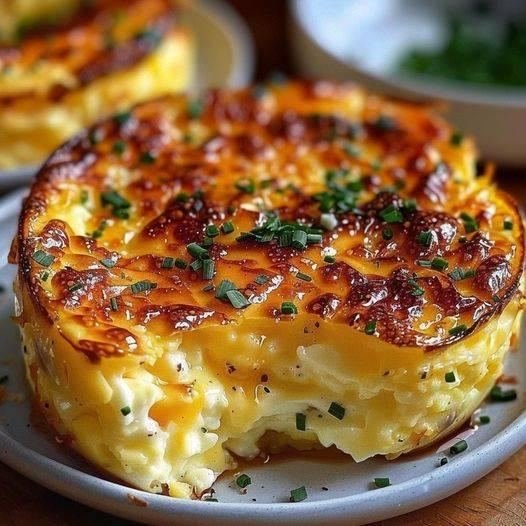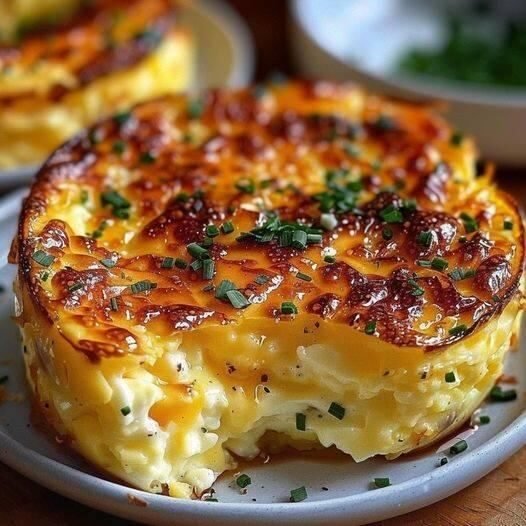Ingredients You’ll Need
Here’s what you’ll need to make this indulgent yet wholesome dish:
- 6 large eggs
- 1 ½ cups cottage cheese (preferably small curd, full-fat)
- ½ cup shredded cheddar or mozzarella cheese
- ¼ cup milk or heavy cream
- 1 tablespoon melted butter
- Salt and freshly ground black pepper, to taste
- ¼ teaspoon garlic powder (optional)
- Chopped chives or parsley for garnish
Each ingredient plays a crucial role in creating the perfect balance of texture and flavor. Eggs provide the structure, cottage cheese offers creaminess, and the shredded cheese gives that irresistible golden crust.

Preparation and Pre-Bake Setup
Before you begin, preheat your oven to 375°F (190°C). Grease individual ramekins or a small baking dish with butter or nonstick spray. This will prevent sticking and give the edges a lovely caramelized finish. If you’re preparing this for multiple servings, individual ramekins make for an elegant presentation and help control portions easily.
Step 1: Whisking the Eggs
Crack the eggs into a large mixing bowl. Whisk them until smooth and frothy. This step introduces air into the mixture, resulting in a fluffier final texture. A good tip is to whisk vigorously for about 1–2 minutes—this ensures the eggs will rise slightly during baking and hold their shape beautifully.
Step 2: Combining Dairy Components
Add the cottage cheese, milk (or heavy cream), and melted butter to the whisked eggs. Stir gently until the mixture is well combined but not overmixed. You’ll notice small curds of cottage cheese throughout—don’t worry, they’ll melt into the mixture while baking, leaving behind small creamy pockets of flavor.
Step 3: Seasoning and Flavor Enhancement
Now, season the mixture with salt, pepper, and a touch of garlic powder if desired. The seasoning might seem simple, but it’s vital to balance the flavor. A pinch of nutmeg can also be added if you want a more aromatic depth—this trick is often used in quiches and soufflés.
Step 4: Layering and Baking
Pour the mixture into your prepared baking dish or ramekins. Sprinkle the shredded cheese evenly over the top. Bake in the preheated oven for 25–30 minutes, or until the top is golden brown and a knife inserted in the center comes out clean. The edges should be firm, while the center remains tender and slightly creamy.
Step 5: Resting and Garnishing
Once baked, remove the dish from the oven and let it rest for about 5 minutes. This resting period allows the structure to set and the flavors to deepen. Sprinkle freshly chopped chives or parsley over the top for a burst of color and freshness.
Serving Suggestions
Baked Cottage Cheese Eggs can be served warm straight from the oven. They pair beautifully with toasted sourdough bread, sautéed vegetables, or a fresh garden salad. For a more indulgent meal, you can serve them with smoked salmon, avocado slices, or roasted potatoes. This dish also works well as a high-protein side for brunch buffets.
Nutritional Benefits
This dish is rich in protein and essential nutrients while being moderate in carbohydrates. Cottage cheese contributes calcium and probiotics, while eggs add high-quality protein and vitamins A, D, and E. Together, they make a balanced meal that supports muscle recovery, bone health, and sustained energy.
A serving of baked cottage cheese eggs typically provides around:
- 250–300 calories
- 20–25g protein
- 4–6g carbohydrates
- 15–18g healthy fats
Make-Ahead Tips
One of the best things about this recipe is its flexibility. You can prepare the mixture a night before and refrigerate it covered. In the morning, simply bake it fresh. Alternatively, baked portions can be stored in the refrigerator for up to three days. Reheat in a preheated oven at 325°F (165°C) for 10–12 minutes for best results.
Variations and Flavor Twists
This recipe serves as a wonderful canvas for creativity. Try adding:
- Sautéed spinach or kale for an earthy note
- Crispy bacon bits or smoked ham for extra savoriness
- Caramelized onions or roasted bell peppers for sweetness
- A sprinkle of feta or Parmesan for a tangy finish
You can even transform this into a crustless quiche by adding chopped vegetables and baking it in a larger dish.
Texture and Taste Notes
The texture of baked cottage cheese eggs is one of its highlights. The outer layer develops a slightly crisp, caramelized surface, while the inside remains creamy and airy. The contrast between the golden top and the soft interior makes every bite satisfying and comforting. The mild tang of cottage cheese enhances the richness of the eggs, creating a perfect balance that appeals to both children and adults alike.
Perfecting the Bake – Chef’s Tips
- Use room-temperature ingredients for even baking.
- Avoid overbaking, as it can make the texture rubbery.
- Mix gently, preserving some of the cottage cheese curds for texture.
- Experiment with herbs like dill, thyme, or basil for different flavor profiles.
- Add a touch of cream cheese for an ultra-creamy texture.
Culinary History Insight
While the exact origin of baked cottage cheese eggs is difficult to trace, similar recipes have existed for centuries across Europe and North America. Cottage cheese, often made from curdled milk, has been a staple since ancient times. The combination of eggs and cheese in a baked form reflects traditional farmhouse cooking—wholesome, resourceful, and deliciously satisfying.
Storage and Reheating
Leftovers can be stored in airtight containers in the refrigerator for up to three days. To reheat, place in a preheated oven at 325°F until warm throughout. Avoid microwaving, as it can make the texture uneven and rubbery.
Pairing Ideas
Pair this dish with:
- Fresh fruit salad for a refreshing balance
- Hot coffee or herbal tea for breakfast
- A glass of sparkling water with lemon for a light lunch
Conclusion
Baked Cottage Cheese Eggs are more than just a meal—they’re a comforting culinary experience. The dish captures the essence of homemade comfort with a gourmet touch, making it suitable for any occasion. With its creamy interior, golden crust, and endless flavor possibilities, this recipe deserves a regular spot in your kitchen rotation.

